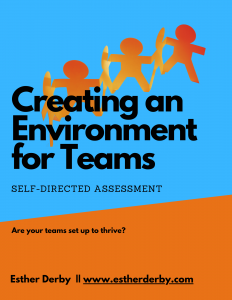I wrote an article about the many ways that managers inadvertently plug the communication pipeline (free registration required). In doing so, they deprive themselves of the information they need to do their jobs. It reminded me of one of the most common ways managers block information–talking too much, listening too little. Some advice for managers…
***
I recently observed a manager meeting with a team member. The manager gave the low-down on a leadership change at the top of the company, speculated on the economy, described his plans for the future, and detailed his mother’s heart attack.
At the end of the meeting, the manager smiled at the team member and said, “Keep up the good work. You’re doing a great job!”
How would he know?
The team member barely got a word in edgewise, and certainly didn’t have an opportunity to describe what he was working on.
Watch the Conversational Balance
In a social situation, a 50/50 balance between talking and listening feels comfortable. But management conversations are different. Managers need to understand how people are working, and where they need help. Managers need to understand the status of work, risks, and obstacles. The manager described above talked 95 percent of the time and listened 5 percent of the time. 30 percent talking and 70 percent listening is a more appropriate balance for management conversations.
Prime the Pump
Aiming for a 30/70 balance doesn’t mean you sit there silently and wait for the other person to fill the silence. Nor does it mean that you need to listen to a rambling monologue that doesn’t provide the information you need to do your management job.
Hone your questioning skills to help you explore the work and understand your team members. Ask open-ended questions, questions that invite expansion, to draw out relevant information. Open-ended questions often start with “What” or “How”.
Some of the questions I find useful in starting conversations with team members are:
• What’s going well?
• What’s keeping you up at night?
• What obstacles are you running into?
• How did you approach the ____________ issue we discussed last week?
• Tell me about your work on __________.
Ask probing questions to gain further insight:
• What else?
• Can you give me an example?
• What’s behind that?
• What else have you tried?
• What other information would be helpful?
Closed questions often start with “Can”, “Do”, “Are” or “Is.” Closed questions naturally lead to a one-word answer. A steady stream of closed questions feels like an interrogation: use closed questions when you want to confirm specific information.
• Did you check with Fred on that?
• Did you try the transaction under load?
Avoid “Why?” Questions
Of course, you want to know why, but asking “Why?” isn’t always the best way to find out. “Why?” questions put people on the defensive. Try asking questions that start with “How” or “What” to understand the reasons behind an action, approach, or decision.
• How did you arrive at that conclusion?
• What factors did you consider?
Ask One Question at a Time
I once sat in on a planning session where the leader started by asking a series of questions — eight of them (I counted). “Well, what are your answers?” he asked, looking expectantly at the dazed group. No one knew where to start. Should they start with the first question (if they remembered it)? The last? Some where in the middle?
Compound questions have the same effect:
“How are you doing on the performance tests – and are we getting anywhere with the memory leak – or is Ted handling that now, and is he able to work independently on that or is Sally helping him and how is that effecting the load testing?”
If you really want answers, ask one question at a time, and then…
Wait for an Answer
Some people like to think then talk. Others like to talk as they think. Our industry tends to have more people who like to think, then talk. So when you ask a question, give the other person some time to answer, pause, and count to ten. Wait patiently. The other person will answer.
The Other Side of the Desk
What can you do when your manager doesn’t leave room to get a word in edgewise?
Based on what I’ve seen, many people, like the 95 percent talk manager I observed, are unaware of that they are dominating the conversation. Some managers are uncomfortable with silence. Others assume that since the other person isn’t jumping in, they don’t have anything to say.
The trouble is, when you don’t share the same style, jumping vocally can be difficult. Try telegraphing your desire to speak in other ways:
• Send an email ahead of time with the topics you’d like to cover. Bring a copy with you to the meeting. Before the manager builds up a head of steam, gently push the topic list across the desk.
• Lean forward, open your mouth as if you are about to speak, and raise your hand slightly. Clear your throat, then begin speaking.
• Wait until your manager takes a breath (everyone has to inhale sooner or later). Start talking.
• Raise your index finger and place it in front of your lips. Most people recognize this as a sign you want them to be quiet for a while.
• If you are comfortable jumping into the monologue, say something like, “Excuse me, I have some information I think you need to know.” Then keep talking.
Managers need excellent communication skills and that doesn’t just mean talking. Part of good communication involves knowing when to ask a question and when to be silent and listen.



Well said. I know that it’s specifically hard for consultants to stop talking, right? But so much of what makes a good consultant is his/her ability to listen, listen, listen, then respond well.
Well said.